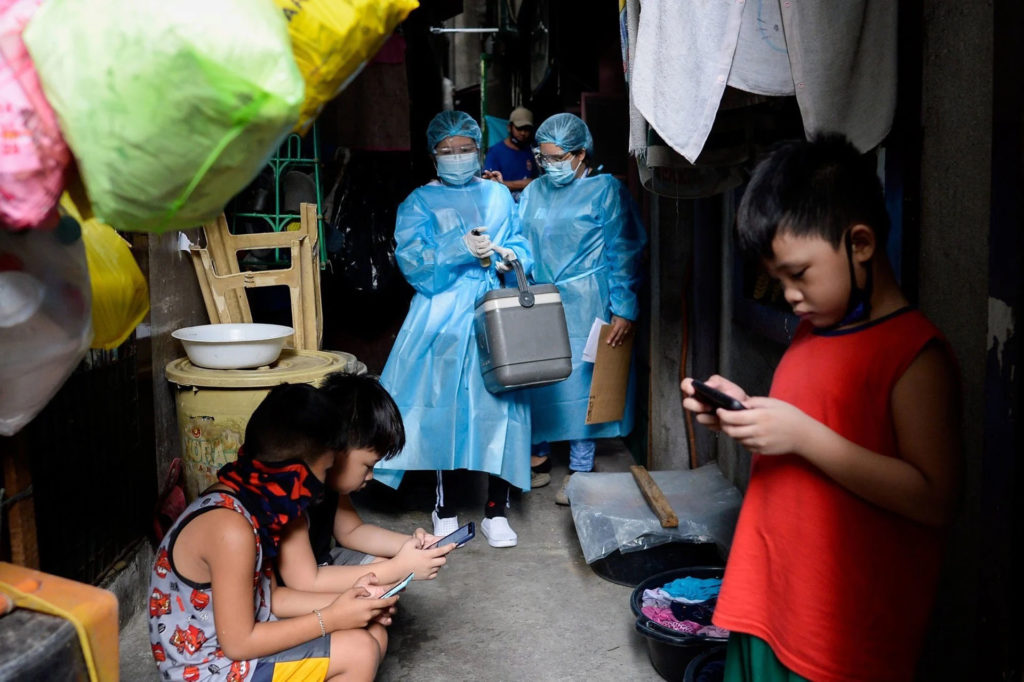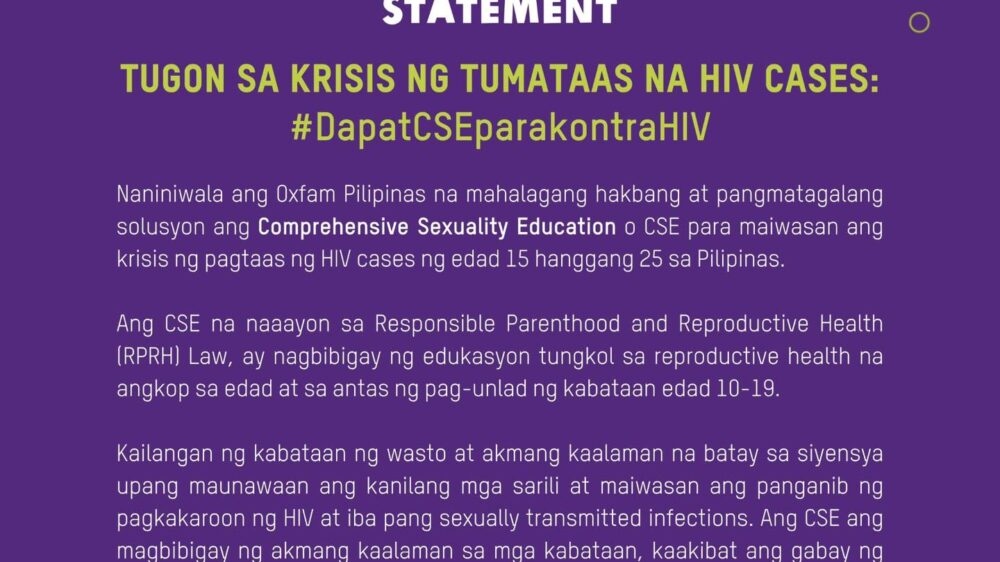This article was originally written by Geela Garcia for South China Morning Post last February 14, 2022 as part of Oxfam Pilipinas’ Journalism Story Grant on Inequality: https://www.scmp.com/week-asia/health-environment/article/3166722/teen-pregnancies-philippines-soar-young-mums-struggle

Erlyn, 18, stopped going to school after the death of her asthmatic brother in 2019. Her friend Daisy, now 16, lost her mother in 2017, the cause of death unclear as the poverty-stricken family had no cash for medical tests; they still blame witchcraft for their loss.
Devastated and needing money, Erlyn began working as a masseuse where she met a man in his early 30s who quickly became her husband, while Daisy left home at 15 to live with her boyfriend, now husband, the same age as her and also out of school.
Motherhood swiftly followed, with Erlyn giving birth to her son Hades in December 2020 and Daisy’s boy Reysy Vee born in October last year.
The youngsters’ early experience of one of life’s main challenges is all too common, with about 500 teenage girls giving birth every day, according to data from the Philippine Statistics Authority. The problem is such that in June 2021, President Rodrigo Duterte signed an executive order declaring the prevention of teenage pregnancies a “national priority”.
Erlyn and Daisy, who live not far from one another in an urban community in Quezon City, near Manila, are raising their firstborns during a pandemic, recovering from childbirth, dealing with breastfeeding and learning lullabies, all while weighing up whether they should – or can – return to their studies or find work.
If their choices were limited already through poverty, they are even more limited now. Erlyn, for one, says she does not want to give birth again. And Daisy, whose son made a rapid appearance in the early hours in the back of a tricycle, is haunted by the painful experience and by the knowledge that her mother-in-law, a poorly-paid snack vendor, is in debt to several people.
Despite knowing the responsibilities involved in becoming a mother, Daisy was determined to carry her son to term. “Aren’t babies a blessing from God? That’s why I kept him,” she said, adding that she and her husband often argued when he could not afford to buy her the food she craved during pregnancy.

‘Worst place to be’
In a pandemic, and in a poorer country, giving birth is even more of a challenge than it usually is, so the fact that the Philippines came last among 53 countries in a Bloomberg study on pandemic response and resilience, dubbing the country the “worst place to be during the pandemic”, is certainly worrying.
Because of the pandemic, some rural health units have had to prioritise their Covid-19 response, said Cecilia Villa, sexual and reproductive health and rights specialist with Oxfam Philippines, which had consequences. “As a result, women had less access to sexual and reproductive health services. Some women had to deliver at home because there weren’t any facilities to take them.”
Erlyn was not allowed to give birth in a large hospital because she did not have the money for the required Covid-19 test beforehand, so she welcomed Hades into the world at a smaller facility with fewer restrictions. A test in the Philippines averages around US$60, while the daily minimum wage of the average worker is US$11. To make end’s meet, during the pregnancy Erlyn’s mother-in-law filed paperwork with government entities that provide funds to subsidise health care for those who cannot afford it.

Poverty is a common thread among many young Filipino mothers. In 2020, more than half of those in their teens – some 57 per cent – were counted among the poorest 40 per cent of the population, according to the Philippine Commission on Population and Development (POPCOM).
Congresswoman Arlene Brosas of Gabriela Women’s Party, which advocates for women’s issues, said poor teenage mothers and their children become even more vulnerable when they lack access to basic health and social services.
“Because of the rise in Covid-19 cases and more hospitals declaring overcapacity, their health concerns were left untreated. What’s worse, the government only allotted 189.76 billion pesos (US$3 billion) for the Department of Health while the budget of the Armed Forces of the Philippines and the Philippine National Police is at 213.78 billion pesos (US$4.1 billion) and 190.69 billion pesos (US$3.7 billion), respectively,” she said.
“This is a grave injustice for women and children who are calling for free mass testing and access to affordable public health care.”
Most teenage mothers in the Philippines are also currently missing out on an education, according to Brosas, who said school closures amid the pandemic and the costs associated with online learning – such as for internet access – had kept many away from class.
Erlyn, though, said it was neither the pandemic nor her pregnancy that had forced her to quit before even finishing high school. She closed her schoolbooks early after her 19-year-old brother died, leaving her to find work to support her mother and sisters – aged 16 and 21. Her father is no longer around.
“Working as a masseuse helped to keep the roof over our heads,” Erlyn said.
She still does not know when or if she can return to school. Now her priority is to have enough money for formula milk and nappies.

Parental consent required
Things could have been different. The Responsible Parenthood and Reproductive Health (RPRH) Act was passed in 2012 to liberalise access to birth control and associated services. However, before adolescents like Erlyn and Daisy can avail themselves of these life-changing services, there is a big stumbling block; the law requires them to have written parental consent.
In a predominantly Catholic country like the Philippines, sex before marriage is frowned upon. The Catholic Church also has a lot of influence on reproductive health laws; it took 14 years before the RPRH bill was passed because of the bishops’ opposition.
Erlyn’s mother Gemma was not happy at first when her daughter revealed in June 2020 that she was pregnant – the two did not speak for several weeks and Erlyn went to live with her husband’s family for a few months, before returning to live with her mother after the dust had settled.
Daisy, meanwhile, lives with her 16-year-old unemployed husband in a capsule-sized makeshift home, a few steps away from her in-laws.

Erlyn and Gemma’s mother-daughter relationship is still strained.
“I told her to finish school first because she can always have a family when she’s older,” Gemma said. “I was 28 when I gave birth to her older sister but I didn’t finish my studies because my mother had passed away. I told Erlyn not to be like me so she won’t suffer the same fate. But what did she do?”
Erlyn began her first sexual relationship aged 15 but her knowledge of birth control and contraceptives is limited, even now. “I thought I’d become a mother in my twenties. I barely use birth control because I’m scared of it,” she said.
Oxfam’s Villa said one of the misconceptions about education relating to sex and sexuality is that it should only be discussed when a child reaches puberty. In fact, parents can talk about sexual and reproductive health and rights, relationships and risks “at a young age. We can speak about it in a teachable manner, that does not antagonise teens”.
“They are usually afraid to approach elders because they will be reprimanded, girls are asked not to entertain suitors because they might get pregnant. But sex can be seen in a positive and healthy way,” she added.
Change is apparently coming to the Philippines. A historic amendment is afoot that raises the age of sexual consent from 12 to 16, President Duterte has signed a bill banning child marriage and a law to ban online sexual exploitation is also on its way.
But it is too late to alter the paths of many young lives. Dr Juan Antonio Perez III, executive director of POPCOM, said the organisation recorded a 14 cent drop in adolescent pregnancies during the pandemic but “this is not the time to be complacent, because there’s also an alarming increase in pregnancy cases among girls aged 10-14, and about 40-50 children give birth every week”.
There is a lot going on to try to improve things. POPCOM hopes to soon implement a special programme aiming to build adolescent-friendly cities, coordinated by local governments. And Villa said she had learned through her work that people are far more responsive to policies if they are created for real needs.
“The needs of preteens aged 10-14 are different from the needs of teenagers aged 15-19 and from the needs of adults aged 20-30,” Villa said.
“In one of our communities there is a working adolescent council that participates in local governance, instead of just an adult council,” she added. “That way, concerns are addressed based on needs, and it also empowers them because of representation.”

Erlyn and Daisy’s ramshackle homes, made from hollow blocks and metal roofs, were built decades ago but may be demolished to give way to upcoming shops and casinos, with families potentially relocated in places far from their livelihoods. Many residents are organising to try to have a say in where they end up.
Eule Bonganay, secretary general of Salinlahi, an alliance advancing children’s rights, said that beyond the home, the state has a big responsibility in raising children and ensuring the participation of communities. Structural inequalities relating to education, housing and livelihoods must be addressed, he said.
“When children are not raised in a way that pleases the status quo the failure is always blamed on the parents, but what the government forgets is that they are the primary duty bearers in ensuring children’s rights,” he added.
“We say it takes a village to raise a child, but when a village is deprived of social services and continues to marginalise its poor because of systemic inequalities, then it remains difficult to build a more inclusive society that supports and cares for women and children.”



